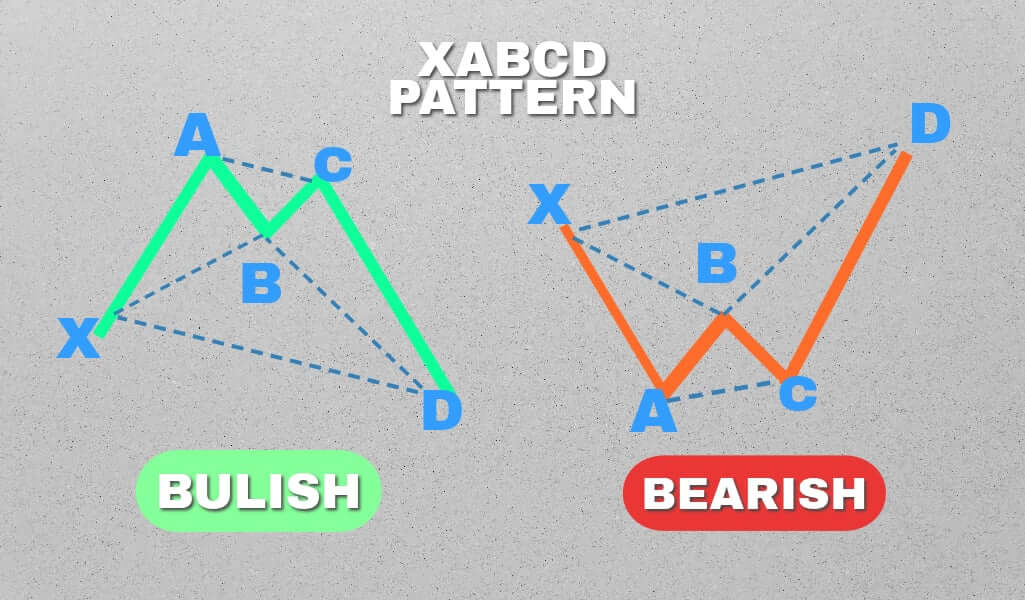
Mastering the Market: Harmonic Patterns cheat sheet
Harmonic chart pattern formations are at the heart of technical analysis. But remembering all harmonic chart patterns is tricky even for experienced traders. Therefore having a pattern cheat sheet could be handy to have them whenever you need.
Even professionals are struggling to decide what pattern to use in a specific market scenario. And the trickiest part is spotting the trading charts and drawing them properly using the right ratios. But don’t worry! We have prepared for you a thorough harmonic patterns guide to easily get your way around.
Harmonic patterns cheat sheet – Harmonic Chart Patterns Types
XABCD Structure
- We start our harmonic patterns cheat sheet with the XABCD pattern since its basic harmonic structure. The XABCD structure is a common framework in harmonic trading, consisting of four key points.
- The XABCD is the base of all other harmonic patterns. It consists of four legs and five points.
- This structure forms the basis of various harmonic patterns like Gartley, Bat, and Butterfly.
- Each leg in the structure adheres to specific Fibonacci ratios.
- The XABCD structure helps traders map out potential price movements in the market.
- Recognition of this structure is crucial for harmonic pattern identification.
Fibonacci Ratios

- Fibonacci ratios are crucial in identifying harmonic patterns in trading.
- Traders apply these ratios to chart segments to predict areas of support or resistance, Fibonacci support and resistance levels.
- Common ratios include 38.2%, 50%, 61.8%, and 100% retracements.
- Fibonacci extensions and retracements guide entry and exit points.
- These ratios underpin the precise structure of harmonic patterns.
Butterfly Chart Pattern
- The Butterfly chart pattern’s extended wings stand out due to its specific Fibonacci measurements.
- It is similar to the Gartley pattern but with a longer AB to CD leg.
- Traders watch for the pattern’s completion at point D to enter or exit the market.
- Point B of the Butterfly pattern can retrace up to 78.6% of the X-A leg.
- The ideal target for the Butterfly pattern is a 127% or 161.8% Fibonacci extension of the A-B leg.
Crab Chart Pattern
- The Crab pattern suggests extreme market conditions and potential reversals.
- This pattern has a high winning probability so you should rely on it absolutely in your trading strategy.
- Its steep retracements and strong movements mark its known characteristics.
- A critical element of the Crab pattern is the extended D leg, which often reaches a 161.8% Fibonacci extension of the X-A leg.
- The pattern’s shape is compact, with a narrow B-C leg.
- Traders use the Crab pattern to anticipate sharp price movements at point D.
Deep Crab Chart Pattern
- The Deep Crab harmonic progression is a variation of the standard Crab pattern with a deeper retracement at point D.
- It has a higher potential for reversals due to the overstretched X-A and B-C legs.
- The Deep Crab often sees point D at a 161.8% or even 224% Fibonacci extension of the initial X-A leg.
- This pattern provides highly accurate potential reversal zones.
- Traders look for the Deep Crab in particularly volatile market conditions.
Potential Reversal Zones (PRZ)

- Potential Reversal Zones are areas where traders expect price movements to change direction.
- Traders often identify them using Fibonacci, harmonic patterns, and other technical indicators.
- PRZs serve as key decision points for entry, exit, or placing stop-loss orders.
- Traders watch for confirmation signals within PRZs before making trades.
- The validity of a PRZ increases with the number of converging technical signals.
Gartley Chart Pattern
- The Gartley pattern, a classic harmonic pattern, resembles an ‘M’ or ‘W’ shape on the price chart.
- Traders identify it using specific Fibonacci ratios to predict potential market reversals.
- It has four key price swings, or legs, labeled X-A-B-C-D.
- The pattern suggests buying or selling at point D, depending on the direction of the trend.
- The Gartley pattern works best when it forms after a significant price movement.
Bat Chart Pattern
- The Bat pattern has distinct Fibonacci levels with a precise 88.6% retracement of the X-A leg.
- Its overall shape looks like a bat’s wings, hence the name.
- It contains five points within its structure: X-A-B-C-D.
- This pattern indicates potential reversal zones when prices reach the D point.
- Traders often set tight stop losses just beyond the point X of the Bat pattern.
Shark Chart Pattern

- The Shark pattern indicates potential price reversals with a shape resembling a shark fin.
- It consists of an ‘O-X-A-B-C’ five-point structure, with Fibonacci ratios defining each leg.
- The O-X leg is often an extreme move, setting the stage for a sharp reversal.
- This pattern provides both entry and exit points at the completion of the C leg.
Cypher Chart Pattern
- The Cypher pattern is a newer harmonic pattern characterized by distinctive Fibonacci measurements.
- It has a visual structure of overlapping triangles creating an ‘X-A-B-C-D’ sequence.
- This pattern usually appears less frequently than other harmonic patterns.
- The B-C leg is crucial in the Cypher and retraces to 38.2% to 61.8% of leg A-B.
- Traders use the completion of point D as a strong indicator for market entry.
Harmonic Patterns cheat Sheet: In Conclusion
We hope this harmonic pattern cheat sheet will simplify the complex task of remembering all patterns for traders.It’s essential for drawing correct patterns using specific Fibonacci ratios, especially for professionals. Recognizing the XABCD structure is vital for identifying potential price movements and reversals. Harmonic patterns like Gartley, Bat, and Butterfly depend heavily on precise Fibonacci measurements for accuracy.
The post Mastering the Market: Harmonic Patterns cheat sheet appeared first on FinanceBrokerage.
